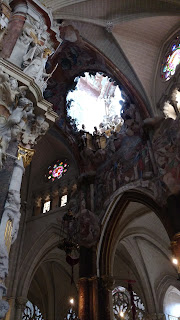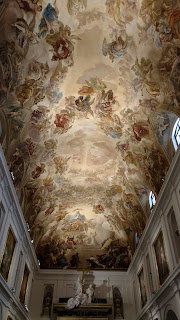Part of what's supposed to be most impressive about the Cathedral here is that it was designed to give a certain sense of weightlessness to the stone. The architect knew that the Cathedral would not be able to compete in scale with the other colossal Gothic cathedrals under construction at the time, and decided to focus on the vaulted ceilings and and presentation instead. He used large windows and enough of them to make a lighter church than others (certainly than the cathedral in Burgos) just using natural light. Lighter colored stone was used and the vaulting in the ceiling was particularly impressive. At one point in the cathedral, 9 different supports all intertwine and meet at the center of just one vaulted dome, many of them branching off into smaller supports down below. The stone really does seem like it almost floats in the air. I'm amazed it was built in 13th century.
One of the highlights of the Cathedral was the story of the Bible carved into the stone around the choir box. It started with the fall of Adam and Eve and went down through many of the major stories. One thing that I thought was really interesting was several scenes from an apocryphal story of Adam's death and his son Seth's quest to help ease his passing. When Seth returns to Adam's death bed, he places three seeds on the tongue of Adam, which allows him to die peacefully. The seeds then sprout into trees, and, according to tradition, the cross Christ was crucified on was made from the wood of one of the trees. The really interesting part, however, is that in most Catholic representations of the crucifixion, and in many Protestant ones as well, there is a skull at the base of the cross. I had always assumed that the skull had to do with it being Golgotha, the place of a skull, but instead, it's actually a reference to this story. The skull is supposed to be Adam's and represent the death of the first man being overcome by the death of Jesus Christ.
The absolute best part of the cathedral, however, is the Transparency. It was originally added after most of the construction to allow more light in. It has paintings, metal and stone scultpures intermixed in an absolutely stunning scene in which the altar seems to be rising up to heaven.
Toledo is also home to El Greco's work. His most beautiful painting in the cathedral was the Expolio, depicting the derobing of Christ just before the crucifixion. He also painted the 12 Apostles, John the baptist and a few other paintings. It was great.
A massive, impressive golden thing called the Monstrance of Arfe was there as well and is just stunning. It was created using some of the first gold brought back from the Americas.
That night we went back down to the Cathedral for the celebration of the 30th anniversary of Toledo as a World Heritage site. We were rewarded with a beautiful light show on the west end of the Cathedral.









That is a psychedelic cathedral! They do a similar light show in France, at Chartres. I didn't get to see it though. But one of our guides said that actually the churches of the Medieval period were brightly colored and so it's possible that they looked much like they do in the light displays.
ReplyDeleteOh wow! I didn't know that. I knew they were colored, but had no idea they would have been so brightly colored. One of the walls here had a few very dull remaining patches of red paint. The white paint has held on a little bit better, but by now looks about the same color as the stone.
Delete